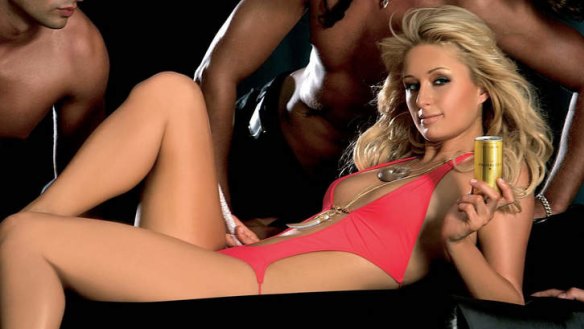Prosecco purists baulk at Paris
The Italians are vehemently opposed to others using the name prosecco.

Whether you agree with the Italians in their campaign to stop the world from appropriating the name prosecco, you would have to agree they have balls and sympathise with them after Paris Hilton was snapped posing with cans (yes, cans) of something labelled prosecco.
''It caused a heart-quake in Italy,'' says Marco Sabellico, co-editor of the Gambero Rosso guide to the wines of Italy, Vini d'Italia.
''In 2009, Italy changed the name of the grape to glera,'' Sabellico said during a seminar on Italian wines in Sydney recently.
''Prosecco is the second-biggest sparkling wine in the world after champagne, with more than 300 million bottles produced per year. The change was a response to the fact that many other countries planted prosecco - South America and other places - all due to the success of Italian prosecco.''
Include Australia in that, especially Victoria's King and Alpine valleys, where Brown Brothers, Dal Zotto, Pizzini, Feathertop and others are busily churning it out.
The European Union recently tried to get the Australian authorities to stop our winemakers from using the name prosecco, and failed. As far as Australian producers are concerned, prosecco is the name of a grape variety and therefore anyone can use the name, as long as the wine comes from true prosecco vines, which is not in dispute.
However, geographical names are a different matter and, according to Sabellico, there is a town called Prosecco in Italy.
''According to European law, if a wine bears a town's name, it cannot be used in other places. A similar thing happened in Hungary with their town called Tokaji.''
The wine is called tokaji or tokay and is made from a grape called furmint. Winemakers in France's Alsace, Australia's Rutherglen and other places are no longer allowed to use the name tokay. This is why the name of Rutherglen's liqueur tokay was recently changed to topaque.
An alternative point of view is put forward by the bible of grape varieties, Wine Grapes: A Complete Guide to 1368 Vine Varieties, Including Their Origins and Flavours by Jose Vouillamoz, Jancis Robinson and Julia Harding. Under the headline Prosecco is a sub-heading that reads ''Misleadingly renamed glera for commercially protective reasons''. Ouch!
The authors don't accept the Italians' claim that the grape's true name is glera. They say glera is a generic name for several grape varieties and its use is localised to the Trieste province. Moreover, the town Prosecco was simply a staging post for the grape as it spread throughout the lands.
Whatever, Australian makers, such as Brown Brothers, which makes a lot of prosecco, are no longer allowed to export it under that name to EU countries but they can still use the name.
Most prosecco is a bland, neutral wine anyway, and often expensive. It is also fashionable. If it wasn't so fashionable, people would care much less about it.
In his masterclass at the recent Top Italian Wines Roadshow in Sydney, Sabellico showed his audience three examples which had impressed the judging panel of the Gambero Rosso guide, culminating in a Tre Bicchieri award for Ruggeri Valdobbiadene Prosecco Superiore Giustino B. Extra Dry 2012. I couldn't see what the fuss was about. It wasn't my idea of extra dry. It was shy of nose, fruity and simple, with appealing delicacy, but hardly an arresting wine. The one I preferred was De Stefani Prosecco Superiore Conegliano Valdobbiadene Brut 2013. With a shy but pretty perfume, it was delicate, refreshing, seamless in texture and appetising. Very quaffable.
Wine bible visits Aussie on its world roadshow for first time
Gambero Rosso's Vini D'Italia, the No. 1 guidebook on Italian wines, is 27 years old this year. Gambero Rosso (red prawn) takes its name from a fictional restaurant in Pinocchio, where the fox and the cat dined together and plotted Pinocchio's fate.
First published as a newsletter in 1987, it's now a big, fat paperback with about 1000 cigarette-paper thin pages, and is translated into English, German, Japanese and Chinese. Italian winemakers boast, not about x number of points from Robert Parker's The Wine Advocate, but tre bicchieri - the maximum three-wineglass rating from Gambero Rosso.
Led by three editors, the tasting panels judge more than 45,000 wines a year, around half of which make it into the guide. The best are rated not on a 100-point or 20-point scale, but between one and three wineglasses.
The Gambero Rosso empire includes guides to Italian olive oil, restaurants and cafes, magazines, and five wine and food training institutions in five ''Cities of Taste'' - Rome, Naples, Catania, Palermo and Turin. And its own Italian TV wine channel.
For the past seven years, it's taken some of the wine guide's highest-rated wines on a Top Italian Wines Roadshow. This year it came to Australia for the first time. Also on the itinerary were Seoul, Mexico City, Osaka, Singapore and Sao Paolo. The centrepiece of the one-day show on March 10 was a walk-around exhibition featuring 63 producers and 250 wines. Mostly, it was an opportunity for wineries to find an importer, but some well-established exporters were there just to wave the flag. They included Gaja, Allegrini, Felsina, Jermann, Ca' del Bosco, Leone de Castris, Elvio Cogno, San Felice, Masi, Volpe Pasini, Sella e Mosca and San Patrignano. The guide's co-editor, Marco Sabellico, presented seminars. The whole thing was aimed mainly at the trade - importers, wholesalers, retailers, sommeliers and restaurant staff, hoteliers, wine buyers and media - but the public was also included in an evening session.
The 2014 edition is $33.58 from bookdepository.com, but I have yet to find it in the shops here. It's likely to be about $70 when it does arrive (the 2013 edition is $69.99 at Dymock's).
